Chapter 6: Types of Business Organisation
Chapter learning objectives
Upon completion of this chapter you will be able to:
- distinguish between different types of business organisation
- explain the meaning of the different types of partnership
- in relation to general or ordinary partnerships:
- discuss how they are established
- explain the authority of the partners in relation to partnership activity
- outline the liability of the partners for partnership debts
- explain the ways in which they can be brought to an end.
1 Types of Business Organisation
Different forms of business organisation
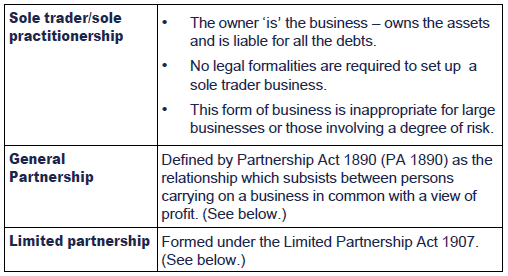

The rest of this chapter will focus on partnerships.
2 Types of partnership
Definition
 A partnership is a relationship which subsists between two or morepersons carrying on a business in common with a view to profit: s1(1)Partnership Act 1890 (PA 1980).
A partnership is a relationship which subsists between two or morepersons carrying on a business in common with a view to profit: s1(1)Partnership Act 1890 (PA 1980).
A partnership can be a small operation or as with some large firmsof solicitors and accountants partnerships with several hundredpartners.
Types of partners
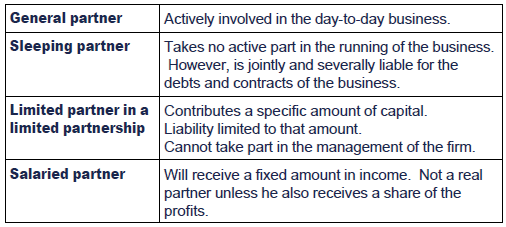
Types of partnership
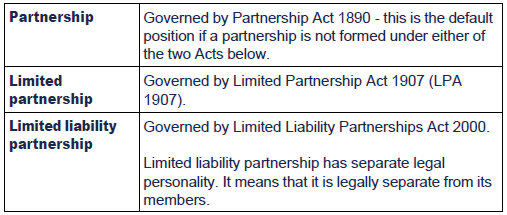
Characteristics of a partnership
In order for a partnership to exist, a business must be carried onwith a view to profit (s1(1) PA 1890). This means that the personsinvolved in the partnership intend the business to yield a profit andthey are all entitled to share in that profit.
The following do not create a partnership:
- joint ownership of property (s2(1) PA 1890)
- the sharing of gross returns (s2(2) PA 1890)
- the sharing of expenses (s2(3) PA 1890).
Cox v Coulson (1916)

A partnership begins as soon as the partners start their businessactivity. The actual agreement may be made earlier or later than thatdate.
The partnership agreement is a contract. Like any contract it may be:
- express (e.g. oral, in writing or by deed) or
- implied.
The partners are contractually bound by the terms they have agreed, even if they conflict with PA 1890.
Limited partnerships under Limited Partnership Act 1907
 A limited partnership is a partnership in which the liability of one or more partners is limited to their capital contribution.
A limited partnership is a partnership in which the liability of one or more partners is limited to their capital contribution.
A limited partnership must fulfil the following conditions:
- There must be at least one partner with unlimited liability (s4(2) LPA 1907).
- The partnership must be registered with the Registrar of Companies as a limited partnership (s5 LPA 1907).
- Limited partners may not participate in the management of the business. If they do, they forfeit their limited liability (s6(1) LPA 1907).
- A limited partner has no power to bind the firm to contracts, i.e. unlike the unlimited partners, he is not an agent (s6(1) LPA 1907).
Partnership around the world
The models outlined above are:
- UK law based
- used in many countries around the world in those forms.
It is also useful to consider partnerships based in the other typesof legal frameworks that were introduced in the first chapter:
- Civil law: société et nom collectif and société en commandite simple (French legal system).
- Sharia law: musharakah and mudaraba.
These types of partnership were examined under the old syllabus.
Civil law partnerships
The société et nom collectif (snc) is a type of limitedpartnership which exists in French law. It is similar to the Englishunlimited partnership in every way except the fact that an snc hascorporate personality and is therefore a legal person in its own right.However, this does not mean that it is responsible for its own debts andthe partners must meet the partnership debts from their own assets inthe same way that English partners do. In addition, the 'managers'(gerants) of an snc (defined in the articles signature of which createsthe snc) may also be liable for the snc's debts.
There must be at least two partners. Partners are treated as soletraders for tax purposes. All partners are gerants and hold importantmanagement rights, most of which can be settled in the articles. Theonly decisions requiring unanimity are the decision to transfer shares,to remove a partner or to cease trading.
The société en commandite simple is another form of commercialassociation in French law similar to a limited partnership in the UK.The key difference from the snc is that some partners are given theright to limited liability.
Sharia law partnerships
Musharakah is a form of partnership in Islamic jurisprudence. It isderived from Shirkah, which means 'sharing' and is divided into twodifferent kinds:
- Shirkat-ul-milk – which relates to the owning of property by two or more persons, and
- Shirkat-ul-'aqd – which refers to a joint commercial enterprise, essentially a partnership created by mutual contract.
Shirkat-ul-'aqd is further subdivided into three types ofcommercial enterprise, one of which is Shirkat-ul-A'mal, which issometimes known as a Musharakah, a partnership relationship establishedthrough a mutual contract. The proportion of profit to be distributedamongst the partners must be determined by that contract, and if it isnot, then no Musharakah is deemed to exist by Sharia law. Partners areliable according to the investment they have made into the business(e.g. if they contributed 20% of the capital, they are liable for 20% ofthe debt). Partners are considered to be agents of one another unlessit has been agreed that some partners are to be excluded frommanagement.
Mudaraba is a contract where at least two parties join in acommercial venture, one of whom has finance and the other of whom has nofinance but, say, ideas and entrepreneurship. The financier(rabbul-mal) enables the entrepreneur (mudarib) to undertake a businessenterprise. The financier is entitled to an agreed share of the profitsbut has no management rights in the enterprise.
3 Authority of partners under PA 1890
Agency relationship
When entering into a contract to carry out the business, each partner is acting as the agent of all the partners:
- The express or actual authority of a partner is set out in the partnership agreement.
- The implied or apparent authority is set out in s5 PA 1890.
S5 PA 1890 states that every partner is the agent of the firm andof the other partners. This means that each partner has the power tobind all partners to all business transactions entered into during thecourse of the partnership's business.
Apparent authority
Under s5 every partner is presumed to have the implied or apparent authority to:
- sell the firm's goods
- buy goods necessary for, or usually employed in, the business
- receive payments of debts due to the firm
- engage employees
- employ a solicitor to act for the firm in defence of a claim or in the pursuance of a debt.
Trading partnerships
The above implied powers apply to both trading and non-tradingpartnerships. Partners in trading partnerships have the additional powerto borrow money.
In order to be acting within his implied authority, the individualpartner must be acting within the usual scope of a partner's powers inthe particular business concerned.
Mercantile Credit Co v Garrod (1962)


 Test your understanding 1
Test your understanding 1
Jekyll and Hyde are in partnership providing forensic services topolice services. The partnership agreement states that all scientificequipment is to be supplied by James and that neither partner may incurliability of more than $2,000 without consulting the other. Jekyll,although he contributed all the firm's initial capital, does not haveany active involvement and visits its premises rarely. Hyde receives asalary, as well as a share of the profits, and works full-time for thefirm.
Jekyll now seeks your advice as he has found out that Hyde has ordered $5,000 worth of equipment from Edgar. Advise him.

4 Liability for partnership debts
Is there liability in contract?
The firm is liable for contracts made by a partner if he was actingwithin his actual or implied (apparent) authority (s9 PA 1890).
The firm is not bound by the implied authority of a partner if:
- the third party knows that the partner has no actual authority, or
- the partner has no actual authority and the third party does not know or does not believe him to be a partner.
Holding out under s14 of PA 1890
Every person who by his words or conduct represents himself (orknowingly allows himself to be represented) as a partner is liable as ifhe is a partner to anyone who thereby gives credit to the firm (S14 PA1890).
Martyn v Gray (1863)
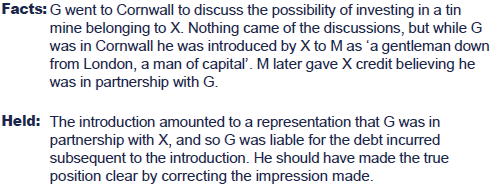
Liability in tort (s10 of PA 1890)
Where a tort is committed during the ordinary course of thepartnership's business, or by a partner acting with the authority of theother partners, the partners are jointly and severally liable to theperson who has suffered loss.
Misapplication of money or property (s11 of PA 1890)
The partnership is liable to make good the loss where a third party's money or property is misapplied:
- after being received by a partner within his actual or apparent authority, or
- while it is in the custody of the firm.
Which partners are liable?

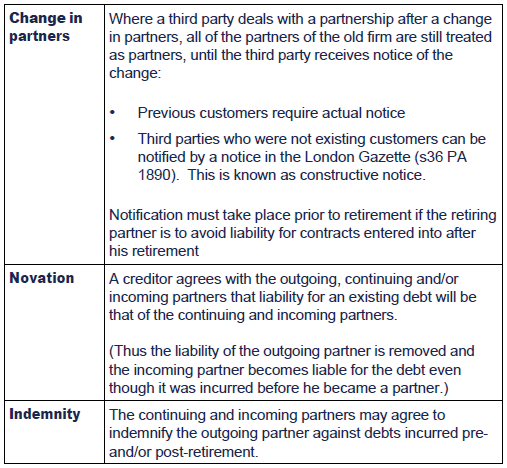

 Test your understanding 2
Test your understanding 2
Following their earlier dispute, Jekyll and Hyde do not believethat they can continue in partnership. It is proposed that Jekyll willretire and Edgar will be admitted as a partner.
What will be the liability for the firm's debts of (i) Jekyll and (ii) Edgar once these changes have been made?

5 Dissolution
Without court order
The partnership will automatically end in the following situations:
- The expiry of a fixed term or the completion of a specific enterprise (s32(a) PA 1890).
- One of the partners gives notice (unless the partnership agreement excludes this right) (s32(c) PA 1890).
- Death or bankruptcy of a partner (s33 PA 1890).
- Where continuation of the partnership would be illegal (s4 PA 1890).
Hudgell, Yeates and Co v Watson (1978)

By court order
Under s35 PA1890, the court can bring a partnership to an end in the following situations:
- Partner has mental disorder or permanent incapacity.
- Partner engages in activity prejudicial to the business.
- Partner wilfully or persistently breaches the partnership agreement.
- Partner conducts himself in a way that it is no longer reasonably practicable for the others to carry on in business with him.
- Business can only be carried on at a loss.
- It is just and equitable to do so.
Distribution of assets
In the event of dissolution the assets of the partnership will beused to pay off the debts of the partnership. As a partnership does nothave the advantage of limited liability status, if the proceeds on thesale of the assets does not cover the debts then the partners' personalwealth will be called upon to make up the shortfall.
The proceeds from the sale of the assets will be applied in the following order:
(i)paying debts to outsiders:
(ii) paying the partners any advance they made to the firm beyond their capital contribution i.e. a loan
(iii)paying the capital contribution of the partners.
If there is a residue remaining this will be divided between thepartners in the same proportion in which they share the profits of thepartnership.
In the event that the assets are insufficient to meet the debts tooutsiders then profits held back from previous years or partners'capital will be used to make good the shortfall. If these are alsoinsufficient then the partners will individually contribute in theproportion to which they shared in the profits.
6 LLPs
A limited liability partnership (LLP) is a corporate body whichcombines the features of a traditional partnership with a company.
LLPs are covered in the next chapter once we have covered the characteristics of a company.
Chapter summary
Test your understanding answers

 Test your understanding 1
Test your understanding 1
PA 1890 states that a partnership is a relationship which subsistsbetween two or more persons carrying on a business with a view toprofit. Each partner is liable for the debts of the firm.
Jekyll is a sleeping partner who takes no part in the running ofthe business, but he is treated as any other partner with respect to hisliabilities.
Hyde is a salaried partner which means that he can run thebusiness. Any act done within the ordinary course of the firm's businessis binding on all partners and they are jointly liable for the debts ofthe business.
When Hyde enters into the contract with Edgar, he is exceeding theauthority given him in the partnership agreement. However, thepartnership agreement is not a public document and Edgar could not beexpected to know of any limitation imposed upon Hyde's authority. Inaddition to express authority, every partner has implied authority unders5, to enter into contracts on behalf of the business. As long as theequipment could be used in the ordinary course of the business, thecontract will be binding on both parties.
When Hyde enters into the contract with Edgar, he is acting inbreach of the partnership agreement. Jekyll can sue for breach ofagreement and recover damages for any loss he suffers.


 Test your understanding 2
Test your understanding 2
A partner who has retired from the firm is not liable for any debtsthat arise after his or her retirement. He or she must notify thepartnership's usual suppliers of his retirement and make sure that hisname is taken off the list of partners.
A notice should also be placed in the London Gazette to give noticeto the persons who have not previously dealt with the firm that he isno longer a partner.
Jekyll will continue to be liable for the debts that arose while hewas still a partner. However, it is possible to avoid this by agreementwith Hyde, Edgar and the creditors.
An incoming partner is only liable for the debts arising after hebecame a partner. However, if there is an arrangement with the creditorsby which the new partners assume the obligations of the old, Edgar willbe liable for the old debts as well. This agreement can be express orit can be implied from the conduct of the partnership.

|
Created at 5/24/2012 2:47 PM by System Account
(GMT) Greenwich Mean Time : Dublin, Edinburgh, Lisbon, London
|
Last modified at 5/25/2012 12:54 PM by System Account
(GMT) Greenwich Mean Time : Dublin, Edinburgh, Lisbon, London
|
|
|
|
 |
Rating
:
|
 Ratings & Comments
(Click the stars to rate the page) Ratings & Comments
(Click the stars to rate the page)
|
 |
Tags:
|
|
|
|
|